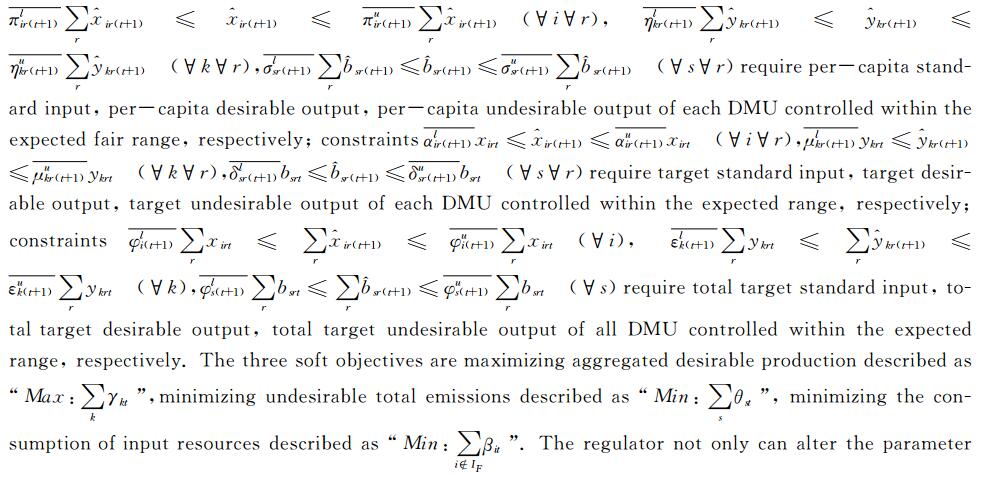It can provide a reference for formulating reasonable resource allocation scheme that assesses Input-Output efficiency and improving potential according to the manager's expected objectives. As a nonparametric approach, DEA-type approaches have several most obvious advantages relative to traditional parametric approaches-no specification of a specific parametric functional form is required, nor is specification of error structures, thus avoiding possible specification error. Another advantage is the ease with which technologies with multiple outputs and inputs. Furthermore, these technologies can be estimated even in the absence of prices or costs, which proves useful when we wish to model joint production with undesirable outputs and useful for analysis in environmental and natural resource applications. The existing literature has achieved fruitful results in the research of DEA model. However, shortcomings exist.
Firstly, Most of the existing DEA models evaluate the efficiency of each Decision-Making Unit (DMU) and allocate resources according to the previous data. However, the optimal efficiency in the past does not represent the optimal efficiency in the future. According to the economic principle, the optimal resource allocation in the future period can only be realized according to the optimal efficiency of each DMU in the future period. According to the historical data, each DMU's technical growth rate of every period is calculated, and then each DMU technical growth rate of future is forecasted so that acquires the prospective efficient frontier.
Secondly, each DMU's input-output efficiency is measured in DEA models by moving the actual input-output point of each DMU to a point on the production frontier; path improvement is merely movement of different points of the production frontier. However, in actual economic management, such assessment of the potential for efficiency improvement and resource allocation is limited; in the real economy, management often achieves some of the desired goals. Managers want to assess how much DMU's actual input-output space must be improved to meet the managers' expectations, as a basis for allocating resources. Goals pursued by managers are often complex and multi-purposed, not merely consisting of the pursuit of economic and technological optimization, but also considering social goals, such as social equity.
On the basis of the DEA model proposed by Adler & Volta(2016), a DEA model of resource allocation is constructed based on future efficiency with consideration of fairness and efficiency. With nine rigid objectives constraints the proposed approach has three phases, which correspond to three soft objectives that are pursued lexicographically. The nine rigid objectives constraints are as following:constraints.

values of the six rigid objectives and define the relative priority of these objectives, but also can set reasonable desired objectives according to the potential of energy saving and emission reduction assessed in every phase, thus forming various objective-oriented allocation scheme which considers to Efficiency and Equity.
At last, the DEA model for empirical analysis is applied to allocate Carbon Emission Rights in each China's Province. Each province is regarded as a DMU. Each DMU's inputs and outputs are that inputs are labor, energy, fixed capital; desirable output are Gross Domestic Product (GDP); undesirable outputs are solid waste emissions, waste water and carbon emissions. Because some data are unavailable and the statistical caliber is nont consistent, 29 provinces are included in this study; the Tibet Autonomous Region, Hong Kong Special Administrative Region, Macao Special Administrative Region, and Taiwan Province are not included in the analysis, and the Sichuan Province and Chongqing City are merged into one province (Sichuan) before administrative division.In the empirical analysis, the proposed DEA method solves the problem of potential assessment and responsibility allocation of carbon emission reduction in China's provinces. On the one hand, the total amount of carbon emissions are reduced by 8% than the current emissions, on the other hand, the gap between per capita carbon emissions and reasonable per capita carbon emissions has narrowed, thus both the equity and efficiency are realized.
In general, the DEA model of this paper has four characteristics. ① the DEA model allocates resources in the future period based on the future efficiency. ② the DEA model sets targets on the basis of potential evaluation, which makes the resource allocation scheme more feasible. ③ the DEA model assesses the efficiency and allocates the resource according to the expected goals, which include nine rigid objectives and three soft objectives. ④additional important feature of the DEA model is its flexibility, i.e., a different relative weight
uk、
νsand
μ#em/em# can be given to desirable output
k, desirable output
s and input #em
/em#, so as to form new target formula Max: .
.


